What’s Up, Tiger
Lily?
Twenty years
after the war, “the definitive spy picture” (Gone With the Wind followed the same
procedure).
Hardboiled eggs
are the main ingredient of the Great Egg Salad, he who has the recipe shall
rule the world.
Thus
the Axis.
“Sustained
reasonably well,” thought Variety. “A
jolly oddity,” says Time Out Film Guide.
Take the
Money and Run
A
career criminal from infancy to eight centuries behind bars.
A
tough environment, a weak nature, a no-good, a punk.
Cellist
in the high school marching band, purse-snatcher, petty thief, holdup man, bank
robber, a failure in every sphere.
Interviews
with family, friends and associates, amidst dramatic scenes of his life.
And if it isn’t
raining, he’ll escape from the penitentiary with a gun made of soap and shoe
polish.
Bananas
The
principal crop of banana republics, and the substance of their political
acumen. The satire follows upon
Corman’s Creature from the Haunted Sea and Fleischer’s Che!, Castro’s visit
to New York is the great provocation (it figures also in Hitchcock’s Topaz).
The focus is on his American cult, personified in a girl who leads Fielding Mellish by a course of memorable adventures to head the
revolutionary government in San Marcos, which has ousted a fascist dictator
whose military coup is covered live by ABC’s Wide World of Sports,
beginning with the assassination of El Presidente.
The point of
departure is the New York or Chicago school of filmmaking. The mode of attack
is the style of an independent with the construction of a wit (the budget is
the same as Ritchie’s Downhill Racer or The Candidate), and all
the Marx Brothers rolled into one.
Bananas fulfills the promise of Corman’s earlier film
(even Last Woman on Earth) and Fleischer’s, as a subtle and
comprehensive political satire that leaves no stone unturned, for the pleasure
of examining what crawls beneath it (cf.
René Clair’s Le Dernier milliardaire).
The so-called
“rudeness” of New Yorkers is explained by the hoodlum assault on the subway,
and in the next scene, Mellish calmly helps a fellow
park his car by guiding him into a smash.
Someone,
incredibly, once asked the writer and director and leading man why it was
called Bananas, according to a well-known story.
everything you always wanted
to know about sex*
*but were afraid to ask

An inspiring set
of questions and answers.
do aphrodisiacs work?
Mel Brooks, History of the World:
Part I and so forth.
what is sodomy?
Edward Albee, The Goat, or Who Is
Sylvia?
why do some women have trouble achieving orgasm?
Paul Mazursky, Scenes from a Mall.
are transvestites homosexuals?
John Cassavetes, A Woman Under the Influence.
what are sex perverts?
Ken Russell, Mahler.
are the findings of doctors and clinics who do sexual research and
experiments accurate?
Steven Spielberg, Close
Encounters of the Third Kind.
what happens during ejaculation?
George Lucas, Star Wars.
Sleeper
A logical
extension of Bananas, even more so, since the point had been missed.
Variety went right along, thinking that Sleeper’s
ending was “fumbled”, again missing the point. Canby thought it was “silly” and
“terrific”, as a film.
A capitalist
technocracy run as a police state by a nose fights Bolshevik “wild animals”
abetted by a shnook from the dark dim past of two
hundred years ago, 1973.
The filming is
very prodigious, and in whiteface as a robot the director resembles Harold
Lloyd.
An ass-backward
society poetess (“obviously influenced by McKuen”)
turned revolutionary gunboat and wrong on both counts is the best of all
possible worlds.
Love and
Death
Everyone knows
what it is to be short-sheeted by a political candidate who appears as an angel
to promise respite from the regime, here literally represented.
Napoleon,
Shmapoleon.
Charles Chaplin,
Groucho Marx, Bob Hope.
The loose sword
goosing goes into Spaceballs, innumerable borrowings.
A
film of immense labors to achieve such little gags, like a joke in Annie
Hall.
Annie Hall
Annie and Alvy’s first drive, “a tad rapidly,” parallels the Brooklyn
Bridge by day in the background, and later in a romantic rendezvous it’s lit up
at dusk behind them (compare the bridge visible during the drive “back to the
old neighborhood”), the point being that New York is a city of meanings in just
the same way Los Angeles is to Cassavetes. The material relating to Chippewa
Falls and L.A. in Annie Hall is figurative, the
work (like many of Allen’s films) appears to be casually made up of incidental
materials on the surface but reveals a great artifice and a representation
looked at more clearly.
Duane driving
(with a track-left to his passengers) comes from La Règle
du jeu.
Interiors
Arthur (E.G.
Marshall) leaves her in the opposite direction, that is toward her, by marrying
a somewhat more earthy type (Maureen Stapleton).
The
pseudo-intelligentsia constitute a cottage industry
ripe for the asking, Allen plucks it on the way to Manhattan after his
brilliant defense of the city in Annie Hall.
The basis of Interiors
is the opening text of L’Année dernière à Marienbad,
Allen simply answers the critics by supposing a decorator of these “carpets so
thick and heavy that nothing can be heard, these halls, these galleries.”
Manhattan

Kubrick’s Lolita is another element of this “love
affair with New York”.
Vincent
Canby of the New York Times, “what happens is not
the substance of Manhattan as much as
how it happens.” Richard Brody (The
New Yorker), “a work of delicious paradox.” J. Hoberman
(Village Voice), “solipsism reigns
supreme,” citing Andrew Sarris on American films of the 70s and Joan Didion on vegetable terrines. Halliwell’s Film Guide, “bogged down in earnestness and half-comic
despair,” citing Richard Combs (Monthly
Film Bulletin), “he has scarcely been able to decide on a form for his
‘art’,” and Sarris, “a masterpiece”.
Stardust Memories
It is harbored
variously by a New York Philharmonic violinist (“I sit way in the back”), an English mental patient (who winds up married in Hawaii)
and a French mother (Hollywood Ending).
It progresses as
a train journey to the dump or (rewritten by studio executives) Jazz Heaven or
(finally) a family outing.
A Midsummer Night’s Sex Comedy
The
inventor, the doctor, and the professor. The “spirit box” is a magic lantern (Bergman’s, to look at nature seen
by Allen and Willis, between Fanny and Alexander and Everyone Says I
Love You), that reveals “the unseen world.” Principally, it reveals an
extra-marital affair and releases the wife from guilt, ensuring a happy
marriage.
The Sleeper
gag of the flying machine works both ways. After propounding his theme as
characters, Allen gives you all outdoors to Mendelssohn’s overture. The tenor
is close to Russell’s Women in Love, generally speaking.
A great scene
takes place deep in woods, with the light changing as clouds pass overhead.
Midsummer is evoked in sundry ways, as for example a tracking shot through the
trees with sunlight flickering through in various degrees of round intensity.
Jose Ferrer gives
a wonderful impression, twice, of a rusty singer warming to his song. “Ich grolle nicht,” he sings, and then he says, “I feel like
something devotional,” and so he continues with “The Lord’s Prayer”. Lovemaking
behind the scene evokes Everything You Always Wanted to Know About Sex.
Julie Hagerty in a brief chiaroscuro close-up looks like a
portrait by John Singer Sargent. Woody Allen as the inventor is given glasses
like Leslie Howard’s in Pygmalion.
“There are no
ghosts except in Shakespeare,” says Ferrer, in a line that would have delighted
Eugene O’Neill. There’s a touch of Watteau in
moonlight by the brook. The Katzenjammer Kids make a
cameo appearance.
The script’s
bariolage is made up of a quick, few, fleeting assertions. The professor’s
dream is answered by this dab of Dickens, “Jesus, what did you eat before you
went to bed?”
This was the year
when American cinema lost its footing and fell from the precipice with the
British and the French of thirty years previously. The studios went on making
impossibly dull pictures, and all the wit was in the New Wave
or the Nouvelle Vague, or Woody Allen.
They’re “made to
move up a little in the bed,” these characters. After reconciling with his
wife, the inventor feels he could perform “a healing.” The flirtatious doctor
grows wise, and the exceedingly rational professor discovers an unseen world.
Zelig
A
fable for the ages. It stands
for an hour, monotheizing the stands of conformism,
then metamorphoses very abruptly into uncanned
laughter at the sight of so many funny things abruptly situated “right and slightly
to the rere” of Hitler’s hindquarters.
The technical
acumen is of the savviest. A sort of homage to Le Chagrin et
la Pitié, like Take the Money and Run and Sweet
and Lowdown.
Broadway
Danny Rose
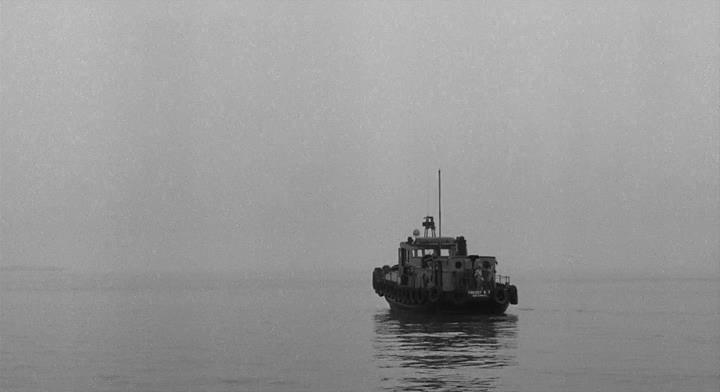
The
Jewish theatrical manager and the Mafia.
“You believe in
God?”
“No—no, but, ah,
I’m guilty over it.”
A
mirror of the war, the whole ethnic underworld thing.
Janet
Maslin of the New
York Times, “one of Mr. Allen's more modest films but also one of his very best.” Variety, “delectable
diversion”. Roger Ebert (Chicago
Sun-Times), “loosens up and has a good time.”
Geoff Andrew (Time Out), “a delightful comedy”. Dave Kehr (Chicago Reader), “tiny, anecdotal comedy”. TV Guide,
“the visual wit and the sentimental drama fall a bit short.”
Don Kaye (Rovi), “a lighter, warmer touch”. Halliwell’s
Film Guide, “generally appealing”.
Gordon
Willis cinematography, Writers Guild and BAFTA to the screenplay.
The Purple Rose of Cairo
New York as the
great capital Hollywood sends you to, the thing goes wrong with “character
believability” and fandom, character and actor both appear to plead their case,
an audience member understands at last the equity and consummation of art.
Marshall’s Goldwyn
Follies has the same idea, Eastwood’s Honkytonk
Man also. This streamlined variant of Stardust Memories goes right
back through the cold æsthetes of Manhattan to
the dilemma of Annie Hall and the resolution of Play It Again, Sam.
The failure of
imagination that turns a great Thirties comedy (The Purple Rose of Cairo)
into The Exterminating Angel is dealt with rather obliquely, but subconsciously
at least a housewife in Jersey wedded to a no-good during the Depression knows
perfectly well it’s all about getting him to her.
Hannah and Her Sisters
This seemed
romantic and simple enough, the religious jokes were easy, so
the critics enjoyed themselves. The actual religious basis is quite different,
and so is the structure, which in turn provides or anyway reveals the meaning,
and that’s why over the years the critics have greatly wearied of a Woody Allen
they have never understood in the first place.
Let us be of what
assistance we can. Roger Ebert is only one critic among many who still maintain
an intense belief in “characters I can believe in,” but there are no
characters, Hannah is no more real than Hamlet (try telling that to a Yale
man). When it comes to film critics, you can’t just up and give the Norton
Lectures all at once, you have to begin at the beginning.
To follow only
part of one strand among many, Mickey’s TV show gets censored over a joke about
child abuse, he gets vertiginous with earache and thinks he’s dying, he
remembers dating his ex-wife Hannah’s sister at some punk rock dive that hurt
his ears, he begins to question the religious validity of his existence, and so
on. It’s the complexity of the total fragmentary approach to the material that
daunts critics (oh, not that critics are ever, ever daunted, far, far from it),
but the only reason for it all is to achieve a variety of articulation alluded
to by Nabokov, “I like to fold my magic carpet in such a way as to superimpose
one part of the pattern upon another.”
In the meantime,
the general technical knowledge displayed in location filming, Max von Sydow’s easy personification of a European painter in New
York, the 360° track for once done purposefully, Lloyd Nolan singing, these are
a few of one’s favorite things. In the meantime, which is to say, failing a
proper analysis of the film that is hardly likely to be forthcoming because, if
you could put your kids through school by eating popcorn, why wouldn’t you?
The dramatic
course is between A Doll’s House and Othello by way of Jane
Eyre, as indicated.
The object is to
attain a free integer, à la Kandinsky.
Not so easy,
bound up in artistic and non-artistic tentacles, but…
The
old song, the old goose-chase.
Radio
Days

The idea of
having burglars winning Guess That Tune
for their victims is not only a proper sacrifice to the muse, it allows a quick
summation of formal utterance to be uttered and dispensed with (the three tunes
are “Dancing in the Dark,” “Chinatown, My Chinatown” and “The Sailor’s
Hornpipe”).
The two main
points of piercing beauty are Radio City Music Hall and Dianne Wiest’s Manhattan ensemble of green hat and dress. Radio
City stands in for the movie palaces that are no more or stand unoccupied or
occupied with swap meets and the like. Wiest’s
costume is a study in itself.
James Stewart,
who taught Woody Allen how to stammer, is seen on the screen kissing Katharine
Hepburn. The type of gag this is adds up to Mia Farrow as Jean Hagen in Singin’ in the Rain suddenly dropping the
other shoe after her diction lessons. There’s a fine joke attributed to W.C.
Fields, involving world leaders and horse manure.
Farrow sings in
her Judy Holliday voice and strikes a vital note of unaffected sincerity (the
scene and the film render homage to Fellini, with Sam Wood’s The Stratton Story, Preston Sturges’ Christmas in July etc.). Diane Keaton
supplies an autumnal tone after the great business of the girl in the well (the
unconscious tragedy of a wartime nation). The rooftop scenes succeed in giving
an impression of the life of the city, with a nuance of The Night They
Raided Minsky’s, ending in “September Song” from Knickerbocker Holiday.
Vincent
Canby of the New York Times,
“unflagging, poetic exactitude.”
Variety, “lacking
the bite and depth of his best work.” Roger Ebert (Chicago Sun-Times), “like a revue in which drama is followed by
comedy and everything is tied together by music.” Rita Kempley
(Washington Post), “we expect more
from a master.” Paul Attanasio (Washington Post), “immediately forgettable.” TV Guide, “a host of anecdotes and remembrances of things past, but
one wishes it could have been slightly more cohesive.” Geoff Andrew (Time Out), “formless narrative,
larger-than-life coincidence, and rambling ruminations”.
September
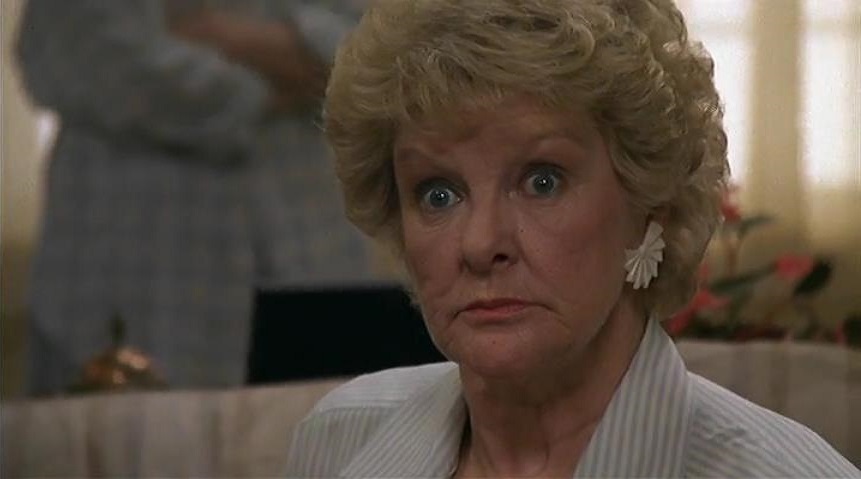
It’s
back-to-school month, the film takes place in August.
A
“period of historical madness”, with reference to McCarthyism and Mildred Pierce (dir. Michael Curtiz) or Where Love Has Gone (dir. Edward
Dmytryk).
The grand
consequences of the summer storm and power failure and two-sided seduction are
quite grave, but left at the end a little up in the air, two days from
September.
Vincent
Canby of the New York Times, “like a possibly
hypochondriacal, invalid ghost.” Variety,
“drenched with Chekhovian overtones.” Roger Ebert (Chicago Sun-Times), “Allen almost seems to be making a modern-dress
Elizabethan comedy. And that may be his point.” Hal Hinson (Washington Post),
“has a more tiresome collection of insufferable, navel-staring bores ever been
gathered together on screen?” Desson Howe (Washington Post), “a heavy plate of
inner struggles and mullings on the randomness of
existence, with flirtatious shenanigans on the side.” Geoff Andrew (Time Out), “rather familiar and
schematic.”
Another
Woman

The writing of a
book is so very strange, it would seem, requiring as it does first a kind of
mental solitude and then a physical one, and entailing various symbolic
procedures only to get at whatever can be found in a book, that it is bound if
represented artistically to look like something else, this film, which ends in
a review (cf. Bergman’s Wild Strawberries).
Sven Nykvist in
Central Park is Edward Hopper.
Vincent
Canby of the New York Times, “Mr. Allen is becoming
an immensely sophisticated director, but this screenplay is in need of a
merciless literary editor.” Variety, “in many ways fascinating.” Roger Ebert (Chicago Sun-Times), “I expected another
chapter.” Pauline Kael, “the picture is meant to be
about emotion, but it has no emotion. It’s smooth and high-toned; it’s polished
in its nothingness.” Joe Brown (Washington
Post), “painstakingly composed and unrelentingly beige”. Rita Kempley (Washington
Post), “has less real emotional content than a
lounge lizard’s rendition of ‘Feelings.’” Jonathan Rosenbaum (Chicago Reader), “an insult to intellectuals and
a piece of posturing phoniness”. Time Out, “in choosing a stylised
approach, Allen too often obscures points in overstatement and intellectual
posturing.” TV Guide, “full of the hand-wringing and
self-consciously intellectual exchanges that characterize Allen's Bergmanesque outings.”
Crimes
and Misdemeanors
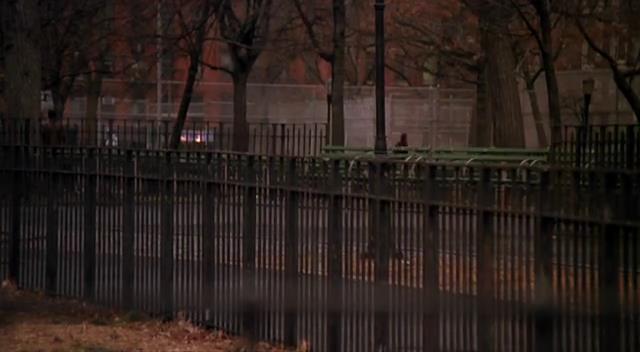
There’s a
prophetic line here about Hollywood endings, because you might just as well say
this is about taking stock of your situation as an artist before you settle in
to work. It has some large implications, and they’re polished off very neatly
with an escapade practically derived from 1984.
The beauty of the
construction is brilliantly articulated.
Vincent
Canby of the New York Times, “a
memorable film.” Variety, “mixed results”.
Roger Ebert (Chicago Sun-Times), “seems to argue that God has abandoned men, and that we
live here below on a darkling plain, lost in violence, selfishness and moral
confusion.” Rita Kempley (Washington Post), “a disparaging word or two on the sorry state of
the world today.” Peter Travers (Rolling
Stone), “the first American film comedy about the absence of God.” Barry McIlheney (Empire),
“marvellously entertaining and provocative”. Jonathan
Rosenbaum (Chicago Reader), “pseudoprofundities”. Geoff Andrew (Time Out), “intriguing and patchily effective.” TV Guide, “morality and murder”.
The Shakespearean
method is employed, marshaling two independent but distantly related works (Fellini’s Juliet of
the Spirits and Disney’s Mickey Mouse cartoon, The Worm Turns) on a hierarchic field, freeing the quill of the
writer to scratch the lines.
The exquisite shots are occasionally animated by a geometric do-si-do in the dollywork. The
special effect is, if that were possible, an improvement of the classic
vanishing act perfected in the Twilight
Zone series.
The two-pronged finale (with a suggestion from The Cocktail Party), involving a bowl of eggnog and Mother Teresa,
may be said to drop first one shoe, and then the other.
Shadows and Fog
It is generally
thought by American reviewers that this has something to do with Kafka’s The
Trial.
The actual
structure is a fairly straight line to the double punchline of Shakespeare’s
sonnets, the need to create as a permanence against
death, and the nature of art.
The main
character is in a swirling dilemma of nincompoops menaced by a strangler, and
underlying this is Bergman’s The Seventh Seal, even Sawdust and
Tinsel if you like.
It’s a dream
within a dream, as Poe would say, with a very funny commentary on “the problem
of evil”, and characters often threatening to give the game away by talking in
the dreamer’s sleep.
The Trial can be analyzed this way, of course.
Husbands
and Wives

The metaphor is
literature, an ideal of style is conveyed as a warm bed on a rainy night (cf. Bergman’s Scenes from a Marriage), the falling away from this is toward the
meretricious and epigonic or toward editorship.
“Boy, I’d hate to
be your boyfriend, he must go through hell.”
“Well, I’m worth
it.”
The capper is
Mark Robson’s Phffft.
Vincent
Canby of the New York Times, “an ensemble
piece acted to loopy perfection”.
Todd McCarthy (Variety), “Allen’s
style has undergone a radical change here.” Roger Ebert (Chicago Sun-Times), “to some degree... his apologia...” Jonathan
Rosenbaum (Chicago Reader), “just
goes to show how superficial his style usually is.” Geoff Andrew (Time Out), “so vividly drawn are all the
characters that one becomes wholly caught up in their tangled whirl of
emotional/psychological confusion: though not consistently hilarious, the film
is engrossing from start to finish.” TV Guide, “greatly indebted to the
improvisatory, pseudo-verite style of John
Cassavetes.” Perry Seibert (Rovi), “seeminly biographical... seemingly influenced...”
Manhattan
Murder Mystery

Hitchcock on television,
“Mr. Blanchard’s Secret” (dir. Alfred Hitchcock), “Don’t Come Back Alive” (dir.
Robert Stevenson), etc.
Cf.
Michael Anderson’s Chase a Crooked Shadow,
John Cassavetes’ A Woman Under the Influence.
Janet Maslin of the New
York Times,
“dated detective story.” Todd McCarthy (Variety), “can be forgotten as easily as it can be digested.” Roger Ebert (Chicago
Sun-Times), “would make Miss Marple
proud.” Desson Howe (Washington Post), “intended to lightly
engage and no more.” Rita Kempley (Washington Post), “decidedly light
fare.” Geoff Andrew (Time Out), “as light and brazenly
generic as Allen's early work.” Hal
Erickson (Rovi), “a real murder and a real mystery”.
Bullets
Over Broadway
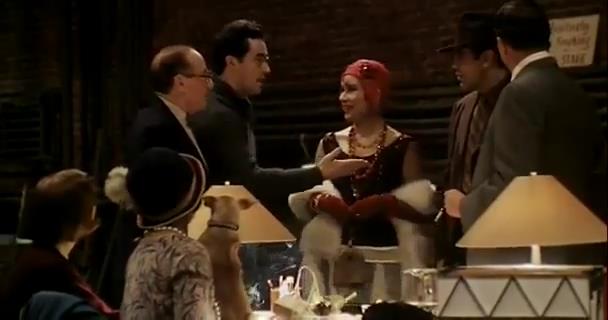
Pinter’s
screenplay of Fitzgerald’s The Last
Tycoon as directed by Elia Kazan is assuredly the basis (“’nor I you,’ who
says ‘nor I you’?”), with a fine transposition of Sunset Blvd. (dir. Billy Wilder) and the central mystery of
Bergman’s Riten
(cf. Hawks’ Twentieth Century).
Janet
Maslin of the New
York Times, “sharp-edged farce”. Todd McCarthy (Variety),
“largely artificial piece”. Hal Hinson (Washington
Post), “the travails of the artist’s life”. Desson
Howe (Washington Post), “it feels
like Woody’s good old days.” Jonathan Rosenbaum (Chicago Reader), “a lively farce”. Time Out, “Allen’s fizziest piece in
years.” TV Guide, “a welcome
return to straightforward comedy.” Don Kaye (Rovi), “romp that, as the
title suggests, combines gangsters with show business at the height of the
Roaring Twenties.”
Mighty
Aphrodite
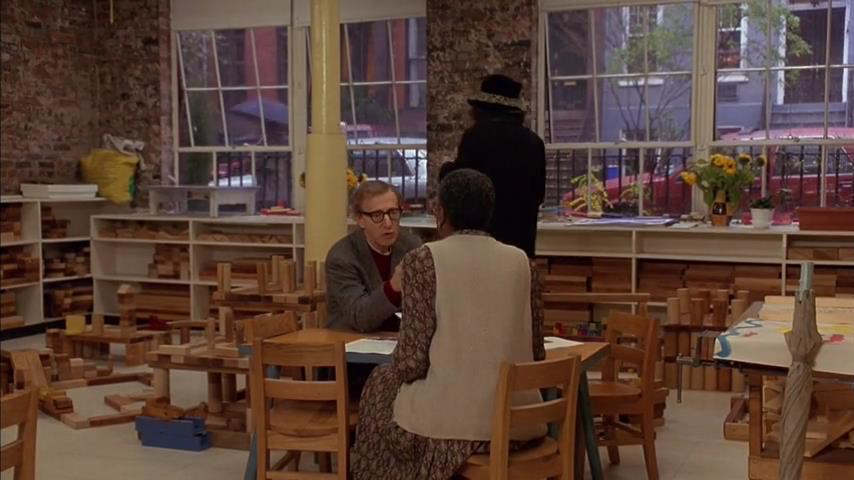
Floating Weeds (dir. Yasujiro Ozu) for the town view
before the arranged date, from A
Streetcar Named Desire (dir. Elia Kazan).
Cinematography
Carlo Di Palma, arrangements Dick Hyman.
The ending goes
into Kubrick’s Eyes Wide Shut.
Janet Maslin of the New
York Times, “at this interesting juncture, Mr. Allen might have given Mighty Aphrodite more heft...” Hal Hinson (Washington
Post), “like an elaborate intellectual rationalization for questionable, if
not creepy, behavior.” Desson Howe (Washington Post), “not a little scary”.
Geoff Andrew (Time Out), “rapidly
palls.” Harlan Jacobson (TV Guide),
“tiresome apologia.” Judd Blaise (Rovi),
“not at
the level of Allen's best-known classics.”
Everyone
Says I Love You

The exceeding
complexity of the film absolves the critical community from all responsibility
for its failure toward Hollywood Ending, misunderstandings multiply until
they efface perception.
The marriage
contract is a theme provoked at the outset. The naturalistic approach (with
unparalleled cinematography of New York and environs) evokes Minnelli in spirit
as much as anything.
The Shakespearean
dichotomies of Goldie Hawn/Drew Barrymore (each with her two men), Grandpa and
Frieda, left and right, etc., set up mirror structures that are the solution of
the work.
The thematic
relationships are isolated in catchphrases, “a raid on the inarticulate,” “this
jailbreak which has succeeded,” etc.
“Does this ring a
bell?” The dance scene on the quay (which recalls, like the “Enjoy Yourself”
number, Disney’s heyday) looks like the same location as the suicide/birthday
banquet in What’s New Pussycat?. The Continent is approached by way of Le Capitaine Spaulding, “de l’Afrique l’explorateur.”
“What is this,
Noël Coward with hockey?”
Janet Maslin of the New
York Times,
“begins very quickly to feel like one more breezy Allen comedy with the
occasional tuneful touch.” Leonard Klady (Variety), “a cinematic oxymoron...
unfettered sagacity.” Roger Ebert (Chicago
Sun-Times), “a freshness and charm that never ends.” Time Out, “decadent as Fred Astaire.”
Film4, “partially
successful”. TV Guide,
“misbegotten musical mishmash”.
Deconstructing
Harry
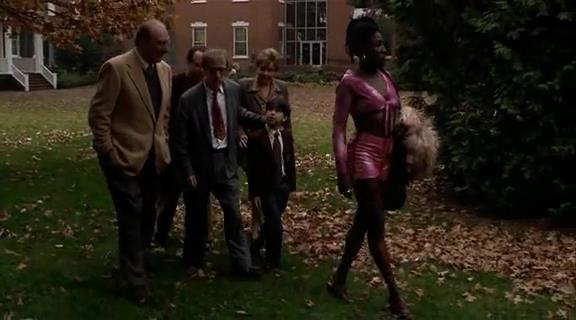
It opens with another from Husbands and Wives, “Oral Sex in the Age of Deconstruction”,
Baisers volés (dir. François Truffaut) follows
that, Domicile conjugal etc., down to Hell and Herzog on the Amazon.
Cf. Rapper’s The Adventures of Mark Twain, Resnais’ Providence.
“Careless filmmaking, desperate shtick, and vainglorious misanthropy”,
said Manohla Dargis in L.A. Weekly, on the strength of which she was hired by the Los Angeles Times as a film critic and then the New York Times replacing Janet Maslin, who also found it “misanthropic” but liked it.
Any resemblance to Harry Black and the Tiger (dir. Hugo Fregonese),
or for that matter Ball of Fire (dir. Howard Hawks), is entirely fortuitous and “purely
coincidental.”
Celebrity

A
remake of Husbands and Wives, “very
arty, pretentious, one of those assholes who shoots all his films in black and
white” (Sven Nykvist cinematography).
“Look who’s
here—Donald Trump! What are you working on, Donald?”
“Well, I’m
working on buying St. Patrick’s Cathedral, maybe doing a little ripdown job and putting up a very very
tall and beautiful building.”
It begins with someone
else directing The Liquidator, and
ends at the premiere.
Janet Maslin of the New
York Times, “but most of what you can tell from the funhouse mirrors of Celebrity is what you already know.”
Todd McCarthy (Variety), “even a 10-minute appearance by the world’s hottest star, Leonardo
DiCaprio, won’t be able to lift this above Allen’s usual low-level B.O. flight
path.” Roger Ebert (Chicago Sun-Times), “sort of a revue
format in which a lot of famous people appear onscreen.” Leslie Felperin (Sight and
Sound), “feels like Allen on autopilot.” J. Hoberman (Village Voice), “tired, sour and
depressed.” TV Guide, “this
self-indulgent wallow in privileged malaise.” Keith Phipps (All Movie Guide), “a crushingly obvious
take on the subject.”
Sweet
and Lowdown

He
leaves behind the pleasant shores of mute admiration for high-toned wiseacreage (“astonish me”, cf. Cocteau’s Orphée) and
this all but fabricated biography.
Janet
Maslin of the New
York Times, “a favorite jazz-lover’s notion.” Roger Ebert (Chicago
Sun-Times), “like a man with a very large dog on a leash. The dog is his
talent, and it drags him where it wants to go.” Amy Taubin
(Village Voice),
“looks like peaches and cream with a dime-store glass of pale gold brandy on
the side. It's the prettiest movie of the year, maybe
of Allen's career... a spectacular performance by Sean Penn that's like
watching someone doing back flips on a high wire with only a worn-out safety
net below him.
“The net is the
film itself... the there-is-no-there-there effect is quite deliberate. It's
what you could call a formal tendency... Related to this aesthetic is
the notion of an art object whose formal perfection is recognized only by a
handful of connoisseurs. The problem for Allen is that, as a form, the feature
film, like the novel, is too unwieldy for perfection... an attempt to make the
film equivalent of an album of music, where the scenes are like separate
tracks. You can have soaring moments and occasions of grace without worrying
too much about how to hold the thing together... narrative sleight of hand—or
maybe just slighting of narrative... the apolitical artist par excellence.
“The film is also
a wish-fulfillment fantasy about the kind of artist Allen could be if he were
not a celebrity...
“This is great
material, but Allen is so careless in developing it that the film is more
interesting to think about after the fact than it is to watch... Penn reveals
the insecurities and delusions-of-grandeur of a pathological narcissist who has
no idea what figure he cuts in the world...
“Sweet and
Lowdown is too slight to
accommodate more than one ego—a larger-than-life model of the filmmaker's own.”
George Perry (BBC), “lots of great
musicians led terrible lives like this.”
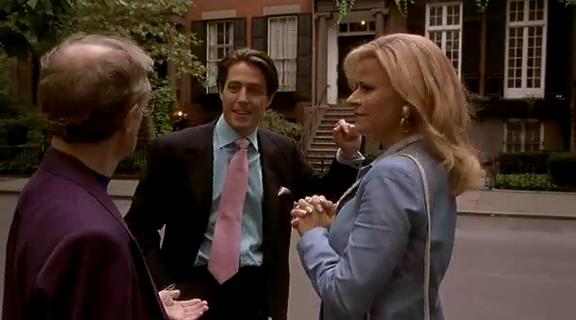
Larceny, Inc. (dir. Lloyd Bacon) stops on the dime of “franchise”. For the rest,
knowing what’s what is from Born
Yesterday (dir. George Cukor) on the basis of Siodmak’s Lured, a by-product is Wyler’s Dodsworth, the Chi Chi Velazquez
Potter caper is Monicelli’s Risate di gioia, the
real finish is Fabergé.
Stephen
Holden of the New York Times, “sweet,
funny wisp of a movie.” Roger
Ebert (Chicago Sun-Times), “a
flat-out comedy”. J. Hoberman (Village Voice), “doesn't pretend to be anything more than a
well-executed caper.” Andrew Sarris (New
York Observer), “may not be the least funny,
most joyless and most mean-spirited movie the Woodman has ever made, but it
comes very close. But that may be just me... a witless caper plot distantly
derived from an old Edward G. Robinson programmer... His take, therefore, on
the vast mass of mankind is, at the very least, uncertain, if not unpleasantly
condescending... flat and obvious dialogue... hopelessly out of date and out of
touch with everything that is going on... period quaintness... use of Elaine
May as an afterthought kind of character is the only interesting element of the
film.” TV Guide, “thin, clichéd
comedy of crime and social climbing packs a lot of padding around its laughs.”
The Curse of the Jade Scorpion
A
satire of the war. It all comes
down to office politics, in a way, that end in marriage. The psychological
functions that govern this are well represented in jewel heists under hypnosis.
The
Hitler-and-Mussolini Vassar girl is an efficiency expert who wants the boss to
leave his wife.
The grubby little
insurance investigator is her bête noire, she despises him as the scum of
the earth.
The settings are
authentic and useful. Color cinematography is simply introduced into well-known
film sets, like a second unit.
Exteriors achieve
the rare sense of the contemporary.
Sounds From A
Town I Love
Cellphones in New York. Everything but long-distance sex with the White
House.
The construction
is a beautiful set of scrims leading from Godard’s Contempt (with Mark Rydell in the Fritz
Lang position) and Pinter’s Tea Party
to Fellini’s 8½
and the Book of Job, the point being to isolate and convey the artist’s
experience in creation, with a result that is remarkably close to Hawks’ His Girl Friday or Twentieth Century, all in a style that doesn’t part ways with a technique
rather like Cassavetes. It’s the sunniest picture in some time, running the
gamut through fog and the lemon light of a New York bar to lemon sunlight on
Manhattan.
The
film-within-a-film suggests Bullets Over Broadway, that Dickensian view of inspiration, and
the film as a whole is a further development of Sweet and Lowdown, which isolated musicianship as such.
Téa Leoni mirrors the theme
in her Hillary hair and Sessue Hayakawa suit (with
Hitler tash underneath?). Debra Messing updates a
perennial mine of laughter, as, for example, Marilyn Monroe in Mankiewicz’ All About Eve.
It’s a startling
thing but perhaps inevitable, Hollywood Ending has finally put the
critics on their mettle to see what their assessment of Woody Allen’s films is.
They have all failed miserably. So bad, so ass-backward has the critical
response been, that Allen himself had to acknowledge
it in Rome recently. “I’m mediocre,” he said, agreeing with his critics, “less
than mediocre.”
Because to make a
spoof of Hollywood around a director who’s blind, which is what all the
critics take Hollywood Ending for, would certainly betray a mediocre
imagination.
But that’s our
critics for you. The purblind leading the totally dumb.
Anything
Else
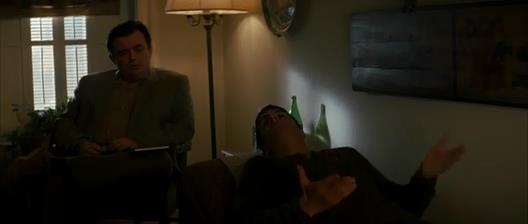
Nothing to do
with Annie Hall but a suite of jokes giving the title, everything with Charlie
Bubbles (dir. Albert Finney).
The surprising
trick is the ease with which at length one is extricated from a
monstrously-conceived trap. The pure surrealism defeated the critics.
An
admirably quiet film, even in Greenwich Village, beautiful setups and a
beautiful technique all the way, beginning with an invocation of Hans Christian
Andersen.
“Tell me about
your dream. You dreamed the Cleveland Indians all got jobs at Toys R Us?”
A.O. Scott of the
New York Times, “at least Mr. Allen has
found the wit to portray younger New Yorkers with something other than
contemptuous indifference.” David
Stratton (Variety), “a mid-range Allen, pic is sharper than his latest offerings, but very far
from top form.” Roger Ebert (Chicago Sun-Times), “an exercise of
neurotic bravery, a defense against fear and insecurity.” Desson
Howe (Washington Post), “doesn't have the energy to be truly horrible.” Michael
Atkinson (Village Voice), “post-teen rom-com”. Time Out, “a pinched
ageing misanthrope whose wisecracks about the Holocaust are screechingly
inappropriate.”
There are
two main precedents (not mentioning Strauss’s Capriccio) for the
premise, Buñuel’s That Obscure Object of Desire (the conversational
presentation) and Donen’s Movie Movie (the
double feature).
Anna Karenina is the basis of the anecdote, or rather a variant
in which the abandoned mistress has killed her lover. Many films are cited in
ways that are very subtle, refined to the nth degree, and it would make a great
game or a fine study to reveal them. Mankiewicz figures in a sense by way of
the décor at least of A Letter to Three Wives, there’s a famous Preston
Sturges shot (camera dollying back around corner on two people walking and
talking), with an added Gogolian sense of dramatic
interest in the incidentals (a couple conversing, hotel guests departing,
sidewalk café waiter with tray), which doesn’t vie in brilliance but in depth,
and there’s Brooks’ The Last Time I Saw Paris.
It’s a
complicated film with a deep structure, and this usually indicates a simple
key. Comedy and Tragedy debate the issue in the form of two playwrights. Funny,
it’s Will Ferrell as Woody Allen with a happy ending (they find true love).
Sad, it ends up being suicidal, and barely prevented.
Both stories are
interlaced as each writer relates his version, sometimes flagging, cast with
audition regulars (the film is an extension of the playlet
in Annie Hall, if you will), well-acted, well-costumed and remarkably
well-designed, it follows various lines as indicated, bobs up and down with the
playwrights’ imagination, and without a lot of kibitzing.
Naturally, the
tragedian thinks life is funny, the comedian that it’s sad. The film concurs
that it’s serious in an ultimate sense, and this constitutes the witness it
bears.
That being said,
it’s a furious masterpiece handled with such virtuosity as to give an
impression of relaxing ease. The two-sidedness is Renoir’s,
everything (everyone) is ridiculous and sublime by turns or at the same time. A
romantic comedy or a domestic drama, laid in the present but intermittently in
the style of, say, Now, Voyager or Mildred Pierce or something
more precise on the one hand, and on the other My Favorite Wife or Manhattan.
And among the countless jokes is the one about comedy and drama in the films of
Woody Allen.
A second fine
shot frames Laurel entering the apartment in a wide rectangular perspective,
articulating the wide screen with a pillar in the foreground right of center
and a flowerpot at its base resting on the bottom of the frame, she comes
through the door in the background right of this, it’s perfectly composed, then
it pans left to Lee at the table answering her.
Apart from this
and the bit of Sturges, it’s a matter of resonance and ambience in the pictures
sustaining and developing the fluctuating inflections of the imagined dramatic
construction, so that if you like Melinda and Melinda can be regarded as
a tribute to the cinema, but the far more complete analysis it provides only
has such a thing as another of its incidentals.
“Melinda had a
reputation for being Postmodern in bed.” The judge may have unfairly denied her
custody of the children, but “it’s all who you know, Laurel, life is all
networking.” Now, Melinda is ready to start over. “I’m an art historian, at
least that’s what I majored in at Brandeis.”
Match Point
A devastating
satire of Yuppies as a class identified with old money and the New World Order.
The entire apparatus is analyzed and presented more thoroughly than ever
before, with the clear prism of An American Tragedy a great help in
these proceedings, and more clearly by dint of the extraordinary labors
expended by Allen on Melinda and Melinda.
He begins with a
slow-motion shot of a tennis ball striking the top of the net and bouncing
straight up. It’s a matter of luck, explains the tennis pro in a voiceover,
whether it will go over or fall back. The shot is repeated identically when
Mrs. Eastby’s wedding ring is hurled toward the
Thames by her murderer and strikes a railing.
The exposition is
perfunctory with a purpose. The Anglo-Irish pro gets a London job and digs, one of his pupils has a wealthy family and a sister.
Allen simply follows all this, gradually introducing one or two startling elements.
The pupil’s fiancée, for example, is first seen quite like Lana Turner in The
Postman Always Rings Twice, and there is just a hint of The Go-Between.
Where all this patient realism and quiet skill leads eventually is a truly
grand vision, the American fiancée in white shirt and jeans viewed from an
oriel window as she walks disconsolately out in the rain through the garden of
an English manor house. The smitten pro follows her to a field suggesting
yellow wheat in the American Midwest.
Now the drama,
which has but little to do with England, is between working at Global
Infrastructure & Finance for the father-in-law in the Gherkin (classes are
provided in the rudiments of business), or pursuing the vision thus made
manifest, and for a time there’s a question whether Dreiser and Stevens
considered in this way will prevail.
These Yuppies
have one common characteristic, they don’t know themselves. Allen films them
without comment, all strongly resembling famous actors (this is perhaps from
Resnais’ Mon Oncle d’Amérique).
The pupil thinks he’s a witty bon vivant, his sister acts the part of
dutiful normality, the fiancée auditions at the Royal Court Theatre, but they
are really a lout, a philistine and a raw Coloradan, somewhat coddled and
altogether pets. The satire consists not in sending them up, but in taking them
at face value in a London of careful appearances, then revealing the actual
drama of their lives, to which they are not privy.
The sedate Postmodern flat overlooking the Embankment and the city is
equipped with daubs of the view. The Saatchi Gallery and the Tate Modern afford
a similar picture of mediocrity (though when the sister opens a gallery of her
own, she finds room in the office area for a small Patrick Hughes). A few notes
of Andrew Lloyd Webber’s The Woman in White are enough to show the
composer is a silly ass, while Caruso singing “Una
furtiva lagrima” is
heard several times with quite different effect.
The murders are filmed
mainly off-camera, with great matter-of-factness. The lovers’ flat is
evocatively seen with a pot of flowers and sunshine, or snow on the balcony.
Scoop
Scoop is akin to Eastwood’s True Crime and
Welles’ Touch of Evil by its “nose for news” as a matter of instinct. A
vague surmise on circumstantial evidence leads a dead reporter to jump ship en
route to Hades and swim back to this nearer shore where, by the fortuitous
intervention of a stage magician called Splendini, he
briefly meets a college journalism major so green she sleeps with an interview
subject after drinks in his hotel room and can’t remember what happened, let
alone the interview.
But she takes the
assignment given onstage in a London theater as she volunteers from the
audience to participate in an “experiment”, Splendini’s
Dematerializer (the disappearance illusion).
A wealthy
businessman’s secretary has died unexpectedly after connecting her employer to
a string of murders by the Tarot Card Killer. The journalism major meets and
falls in love with him, finds more evidence but not enough, the real killer is
caught. Splendini, whose real name is Sid Waterman,
joins the search as her father and uncovers still more evidence. At last the
suspect admits to being blackmailed by a prostitute whom he murdered by
imitating the Tarot Card Killer. The journalism major escapes an attempt on her
life, The Observer gets the story.
It’s the grain of
truth in the original yarn that eventually bears fruit despite all the
obstacles. Waterman goes door to door among the prostitute’s neighbors down
from Royal Albert Hall a few paces, armed with a pencil and paper. “Did you see
All the President’s Men? I was the short one.” There is a profusion of very
funny material rippling from the two big jokes (the dead pro leaping from Charon’s ferryboat and the live amateur who has “a little
problem with promiscuity”) which are borne witness by Richard Johnson and John
Standing as partygoers listening intently to Waterman’s gags, such as, “I was
born into the Hebrew persuasion, but when I grew up I converted to narcissism.”
The advantages of
filming in London are a sense of detachment polishing the mirror of America,
and one should say a revelation about Allen’s technique acquired from long
study of the French. British workmanship is acknowledged in a tracking pan
along the lake that stops on the open boathouse of the family estate and
immediately dollies in, a shot adapted from The Third Man and 2001: A
Space Odyssey.
The businessman’s
London flat is a study in tasteful elegance around a Ben Nicholson on the wall.
Downstairs beside the wine rack is a vault of musical instruments, Blake’s Job
with a vengeance.
London is mainly
seen on the intimate level at which it might be Paris or New York. This
produces striking effects when the locality makes itself known, as at the
swimming pool of the Governors Club, in the cumulative sense of atmosphere, and
also in the Architectural Digest layout of the manor supplemented by
views of the garden and grounds.
After her failed
interview at the Dorchester, the journalism major bewails the comparison to
Katharine Hepburn and Rosalind Russell. Her attempted murder at the lake is a
fine study of reflected light and color on the surface of the water, after the
manner of Hollywood Ending.
Cassandra’s Dream
The
whole story of globalization and its peculiar attractions and its rather odd
mission. The basis of the
anecdotal construction is a variant of such a useful theme as elegantly
deployed in a Columbo called “Double Shock” (dir. Robert Butler, twin
brothers kill uncle, one conservative and the other not). In this London tale,
uncle is a plastic surgeon living in Los Angeles with ties to Switzerland and
Hollywood, his new clinic in China is a great success but a witness to his
practices in business and foundation has to be eliminated lest he testify.
Fortunately, two nephews have a need for help, one to escape loan sharks and
the other to become a Los Angeles hotelier. The garage mechanic knows about zip
guns but is reluctant. The murder is done, his conscience assails him.
The descriptive
labors of Match Point and Scoop have reaped a benefit in simple
formulation and direct expression. The tortured mind of the recalcitrant nephew
gives him no peace, he must be eliminated in turn yet this does not come off.
His brother berates him for spoiling the crime with talk of confessing, the two
wrestle, one falls dead. Instead of going to the police, the unfortunate
perpetrator kills himself.
The direction is
perfect, the performances no less so. The drama is laid in London settings as
an elaborate artifice amid verisimilitude. The city of traffic jams and
riparian entertainments has its pomp and circumstance, a view of Tower Bridge
leading farcically to the Gherkin, a shot or two of umbrageous timeless
dockside London where, under all the gaiety of the New Economy, bodies is
buried as ever (cf. Douglas Hickox’ Brannigan).
Zsigmond’s cinematography gets arching clouds over water and
subtle, luminous landscapes on outings in the country or aboard the boys’ small
craft, named for a greyhound that wins at sixty to one, the title, as beautiful
as Freeman’s Hawaii Five-O. Glass finds his adjunct to film composition
in Bernard Herrmann and writes a perfect score.
The slight
stutter and mixed purpose of various scenes are so lifelike that they
accomplish a unity of droll foreground action and well-observed city
background. The incredible scenery requires no explanation, the café-theater
and industrial wrap-party are taken for what they are without heightening of
effect. The would-be hotelier’s mistress is a would-be starlet, the mechanic
has a down-to-earth blonde very concerned about his mental health toward the
end, he wakes from nightmares out of Boorman’s Deliverance,
evidently.
A
trip to Brighton, last seen in Stardust Memories or first seen there. The beautiful camerawork finishes a movement in an
extraordinarily precise cadential view, as at Lord Eisley’s garden party or outside a pub overlooking the
Thames (where a perfect vertical on the right sets off the dockside view
described).
Action is taken
with a furtherance of the understanding evolved in Match Point that it
must be filmed with dry verisimilitude. The zip guns are tested at the garage, the sound doesn’t ring but flatly conveys instant
death, the tussle on the boat ends with a crash just as plain. Without dramatic
artifice the effect each time produces a stunned, quizzical and above all even
reflection.
The plastic
surgeon has tacitly committed a perfect crime, police have the bodies and the
boat, the girls are out shopping. “Life is nothing if
not totally ironic,” the strange unity works out as divide et impera.
You Will Meet a Tall Dark Stranger
The ultimate
paradox of Surrealism is that nothing looks so much like lack of faith as faith
itself.
Christ is the
title character, he appears as a struggling novelist called Strangler (a
character identified with Luke publishes the nearly posthumous work under his
own name).
Jehovah divorces
his wife, who is Israel, and marries the strumpet Jerusalem.
One has been
Cleopatra and Joan of Arc, says the divorcée, now married to the proprietor of
an occult bookshop. Enmity is put between mother and daughter.
The perfection of
mundane technique is peculiarly engrossing, tilts-and-pans, fine compositions.